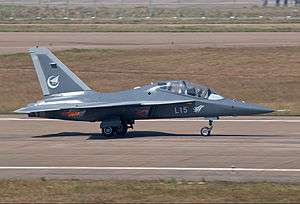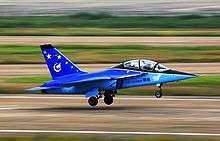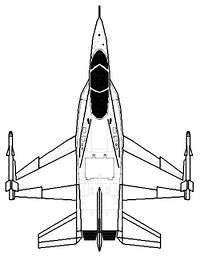Hongdu L-15
| L-15 | |
|---|---|
 | |
| Role | Supersonic trainer/attack |
| Manufacturer | Hongdu Aviation Industry Corporation |
| First flight | 13 March 2006 |
| Introduction | Between 2008 and 2010 |
| Status | Flight testing, limited series production |
| Primary user | People's Liberation Army Air Force |
| Number built | At least 3 prototypes |
| Unit cost | |
The Hongdu L-15 Falcon (猎鹰) is a Chinese supersonic training and light attack aircraft being developed by Nanchang-based Hongdu Aviation Industry Corporation (HAIG) to meet the Chinese People's Liberation Army Air Force (PLAAF) and People's Liberation Army Naval Air Force (PLANAF) lead-in fighter trainer (LIFT) requirements.

.jpg)
Design and development
The L-15 is an advanced trainer aircraft currently under development by Nanchang based Hongdu Aviation Industry Corporation. The aircraft made its maiden flight on 13 March 2006. The aircraft's general designer is Mr. Zhang Hong (张弘), and the development is reportedly assisted by Yakovlev OKB of Russia. The L-15 is a direct rival to the Guizhou Aircraft Industry Corporation (GAIC) JL-9/FTC-2000 Mountain Eagle in competition for the People's Liberation Army Air Force's (PLAAF) next-generation advanced trainer aircraft program.
HAIG unveiled a full-scale mock-up of its L-15 advanced lead-in fighter trainer (LIFT) in the 2004 Zhuhai Airshow. The two-seat, two-engine L-15 features the latest advanced technologies developed by China, such as digital quadruple fly-by-wire (FBW), glass cockpit (two multi-color head down displays for both the front and rear cockpit, and an additional head-up display for the front cockpit), and hands-on-throttle-and-stick (HOTAS) flight control. The look-down field of view for the frontal cockpit is 18°, and 6° for the rear cockpit, exceeding the US requirement. The aerodynamic performance of the aircraft is enhanced by its large leading edge extensions (LEX) design, which gives a maximum angle of attack of 30°. This is very useful when trying to simulate the maneuvers of advanced fourth-generation fighters such as J-10, JF-17 and J-11. JL-9/FTC-2000 Mountain Eagle trainer jet from Guizhou Aircraft Industry Corporation (GAIC) is a direct competitor of the L-15. L-15 has a wide range of more advanced features comparing JL-9, however JL-9's development and production would not rely on key components that can only be imported from foreign suppliers, which is a key benefit comparing L-15 heavily relies on AI-222 series turbofan engine from Ukraine.[1]
With the L-15, student pilots will be able to complete mission flight training and advanced combat training, as well as complete all basic jet flight training courses. The aircraft also has six (four under-wing and two wingtip) pylons to carry various air-to-air and air-to-ground weapons. If necessary, it can serve in the lightweight attack role with minor modifications, carrying up to 3 tons of armament.
The first L-15 prototype (#03) rolled out in September 2005 and made its maiden flight on 13 March 2006, piloted by the two of the chief test pilots of the program, Senior Colonel Yang Yao (杨耀) and Senior Colonel Zhang Jingting (张景亭, unrelated to the chief designer Zhang Hong). The 3rd chief test pilot of the program is Senior Colonel Li Zhonghua (李中华). Currently, Hongdu is actively marketing the aircraft to both domestic and international markets. In April 2006, it was reported that the PLAAF placed orders for 4 L-15 trainers, and small batch production will start in 2007.[2]
Each of the first two units (#01 & #02) are powered by two ZMKB-Progress (Lotarev) DV-2 engines, which do not have afterburners, and these two aircraft thus do not have the capability to reach supersonic speed. The third unit (#03) is powered by a pair of an improved version of DV-2, the DV-2F, with afterburner, so that it can and has already reached supersonic speed. The subsequent production units are expected to be powered by Ukraine's Ivchenko-Progress AI-222K-25F turbofan engines with afterburner once co-production license is obtained by the 608 Institute. Ukraine company also developed a greater thrust of AI-222-28F (thrust 4500 kg) and AI-222-30F (5000 kg thrust) engine. The latter two may be introduced for the equipment and load up more L-15, of course, they may also be used to equip other aircraft in China.[3]
In Paris air show 2013, CITIC representative Ma Zhiping confirms that contract secured to export twelve L15 aircraft to an African country, however Ma did not confirm which country that is. Ma also confirms L15 is configured with three-axis fly-by-wire system, and is able to simulate most Chinese advanced fighter jets, as well as western ones.[4]
In June 2013,the AJT condition of L-15 finalized the design and would be operated by PLAAF with a formal name JL-10.[5] On July 1, 2013, the first batch of JL-10 began to be transferred to PLAAF.[6]
The L-15 is also the first trainer aircraft to be fitted with a PESA radar (Developed by Institute 607).[7][8]
Operators
- People's Liberation Army Air Force (First batch of L-15 is commissioned in a training center of PLAAF in EAST of China, quantity is uncertain based from public information)
In November 2012, an order for twelve L-15s by an unknown customer was announced. They are due to be delivered in 2013.[9] This batch of L-15 is begun to be handed over to the customer on June 29, 2013.[10]
- Zambian Air Force - It was reported in 2014 that Zambia had ordered 6 L-15s for US$100 million.[11] Aircraft 001 made its 1st flight in late 2015,[12] while delivery to the Zambian Air Force is expected in early 2016.[7]
- Venezuela Air Force - Venezuela Defense Minister Carmen Meléndez Rivas revealed in April 2014, ordering 24 L-15.[13][14]
Potential customers
Pakistan[15] are interested in acquiring this aircraft to train its fighter pilots.
Ukraine is considering local production of the L-15 in Odesa.[16]
Uruguay was invited to evaluate the aircraft, in an invitation extended by CATIC to the FAU command to form a committee including Air Marshall W. Martínez and staff. The invitation was coordinated for October 2011.[17]
Specifications

Data from Military-Today[18] L-15
General characteristics
- Crew: 2
- Length: 12.27 m (40.256 feet)
- Wingspan: 9.48 m (31.1 feet)
- Height: 4.81 m (15.78 feet)
- Empty weight: 4,500 kg (9,920 lb)
- Loaded weight: 6,500 kg (14,300 lb)
- Max. takeoff weight: 9,500 kg (20,900 lb)
- Powerplant: 2 × Ivchenko Progress AI-222K-25 for AJT model, Ivchenko Progress AI-222K-25F afterburning turbofans for LIFT model
Performance
- Maximum speed: Mach 1.4 (924.1 mph)
- Combat radius: Over 550+ km (More than 340+ miles)
- Ferry range: 3,100 km (1926 miles)
- Service ceiling: 16,000 m (52500 feet)
- Rate of climb: >200 m/s (afterburning) (>39370 ft/min)
Avionics
See also
- Aircraft of comparable role, configuration and era
- Aermacchi M-346
- Yakovlev Yak-130
- EADS Mako/HEAT
- KAI T-50 Golden Eagle
- Mikoyan MiG-AT
- Hongdu JL-8
- Textron AirLand Scorpion Jet
References
- ↑ "L15 and JL9 trainer jet competition, China PLAAF". AirForceWorld.com. Retrieved 29 Aug 2011.
- ↑ China Defense Blog: April 2006
- ↑ AirFroceWorld.com L15 advanced trainer engine options
- ↑ AirFroceWorld.com L15 advanced trainer jet
- ↑ http://www.cjdby.net/junbeidongtai/2013-06-12/military-4229.html
- ↑ http://www.cjdby.net/junbeidongtai/2013-07-01/military-4448.html
- 1 2 JL-10/L-15 Falcon - chinese-military-aviation.blogspot.com
- ↑ PESA for JL-10/L-15 by Institute 607 - Chinese Internet
- ↑ "L-15s Sold". Air International. Vol. 84 no. 1. January 2013. p. 15.
- ↑ http://www.cjdby.net/junbeidongtai/2013-06-29/military-4426.html
- ↑ Fisher, Richard D., Jr. (30 December 2015). "Zambia to receive first Hongdu L-15 trainer". Jane's Defence Weekly. Surrey, UK: Jane's Information Group. 53 (8). ISSN 0265-3818.
- ↑ AVIC has published photos of first L-15 supersonic training aircraft of Zambian Air Force - defence-blog.com, 28 December 2015
- ↑ http://www.venezueladefensa.com/2014/04/venezuela-adquirio-aviones-de.html
- ↑ http://mil.news.sina.com.cn/2014-04-08/1212772752.html
- ↑ Pakistan Eyes Acquisition of Chinese L-15 Supersonic Jet Trainer
- ↑ Janes
- ↑ http://www.infodefensa.com/?noticia=catic-invita-a-una-delegacion-de-la-fuerza-aerea-uruguaya-a-china-para-evaluar-aviones-de-combate
- ↑ Hongdu L-15 Specification & Performance, Military-Today.
- ↑ http://s12.postimg.org/5c5uprs99/20141212032332_74953.jpg
External links
| Wikimedia Commons has media related to HAIG L15. |
- L-15 at Chinese Defence Today (English)
- L15 Falcon Trainer Jet introduction - AirForceWorld.com (English)
- First flight of L-15 03 (with pictures) (Chinese)
- News article on the maiden flight of the L-15 (with pictures) (Chinese)
- Incomplete recording of development history for L-15 (with pictures) (Chinese)